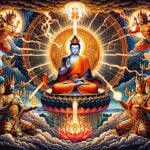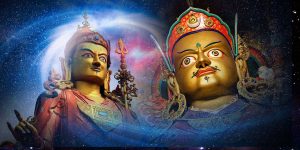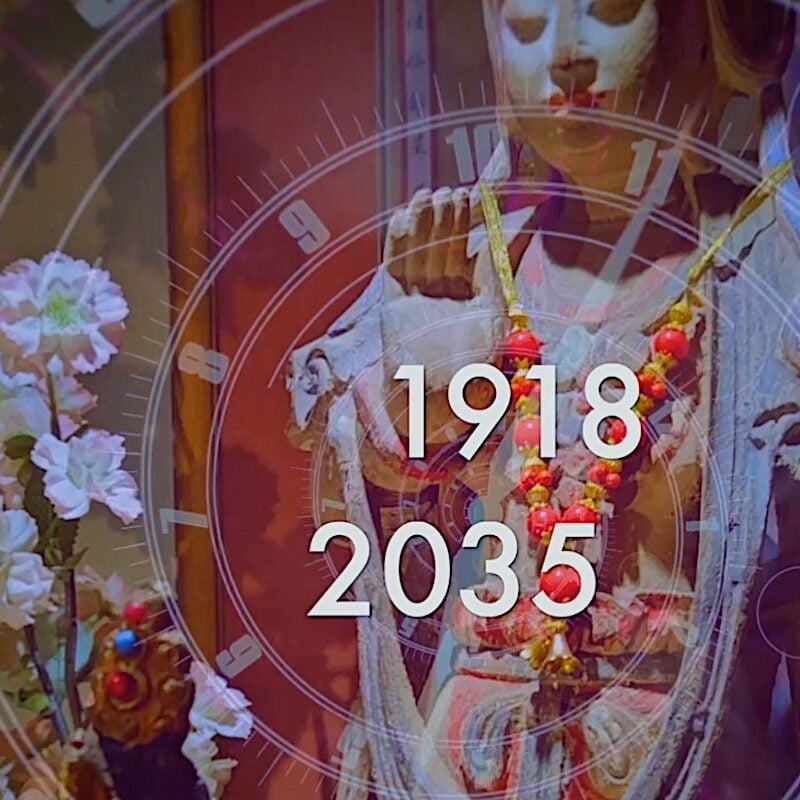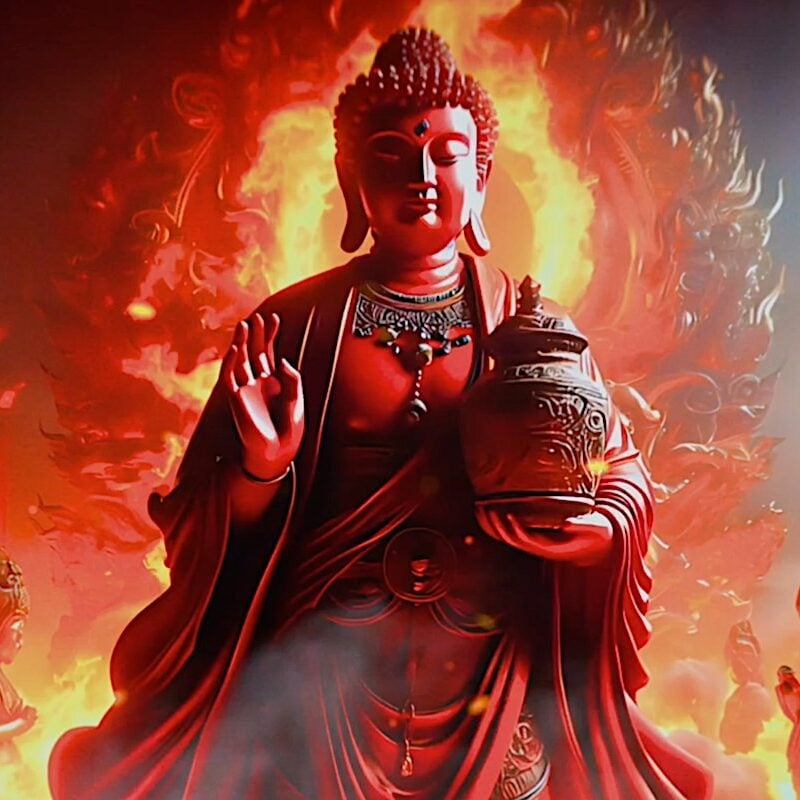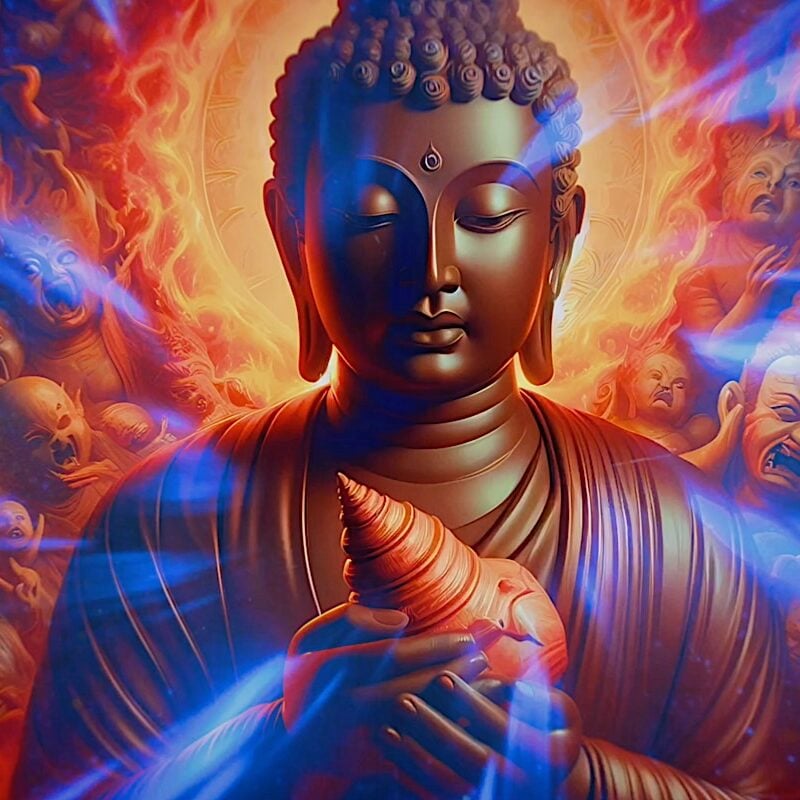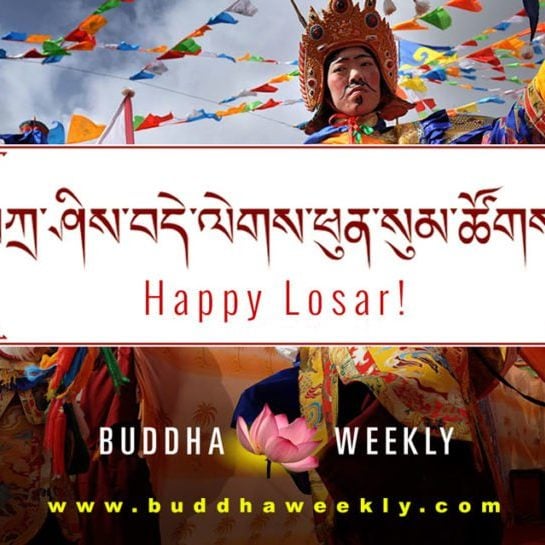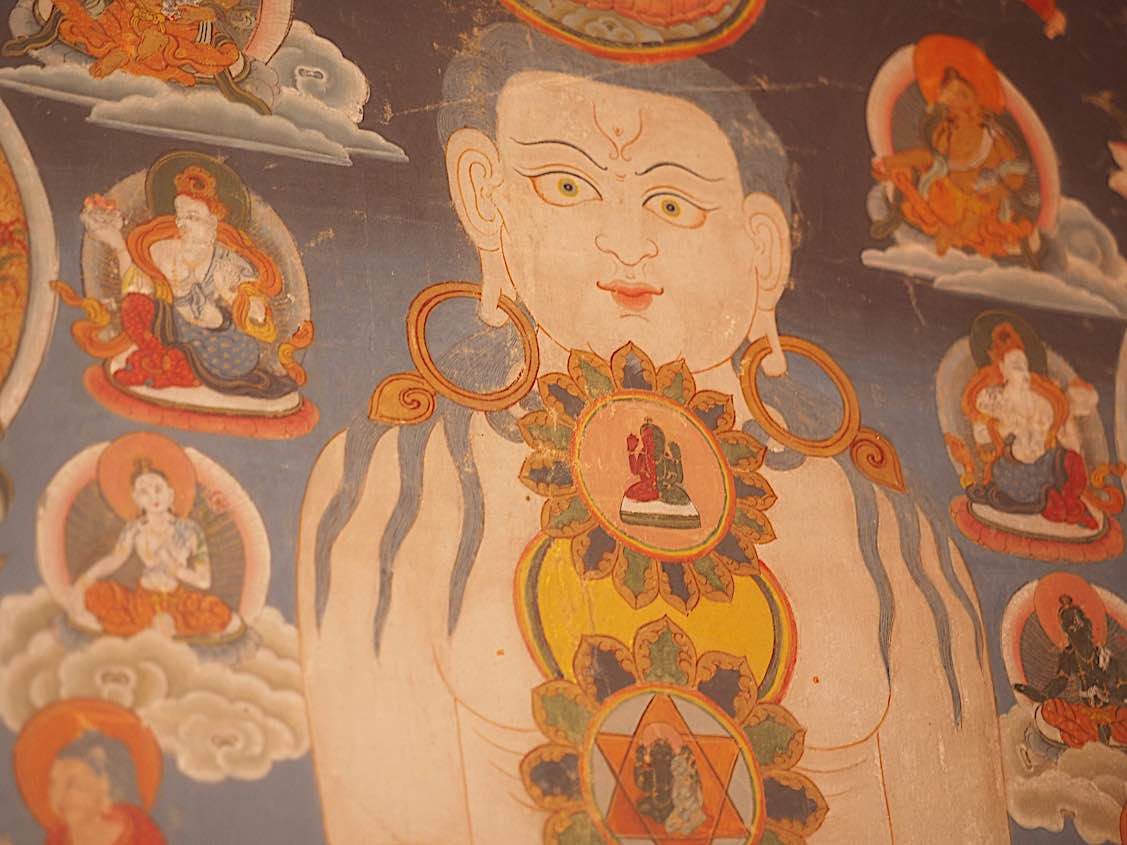“The Dalai Lama will see you now” — chapter excerpt from Threads of Awakening by Leslie Rinchen-Wongmo.
Excerpt: Piece 1 from Threads of Awakening by Leslie Rinchen-Wongmo,
This is an excerpt from Leslie Rinchen-Wongmo’s amazing new book Threads of Awakening. In Threads of Awakening, Leslie Rinchen-Wongmo beautifully tells her story as a personal spiritual memoir, seamlessly weaving (pun intended) elements of artistic tradition and method, personal memoir — and even beautiful descriptions of many popular Buddhas and Yidams. It makes the flow of the narrative very captivating.
- Read her interview with Buddha Weekly with some beautiful photos of her work>>
- Threads of Awakening website>>
His Holiness Will See You Now
DHARAMSALA, INDIA—1997
Voices wafted through the glass doors, muffled by heavy cream-colored curtains decorated with rust-hued flowers and gray-green leaves. We’d been told he was meeting a group of new arrivals on the veranda and would then come inside to talk with us. The Dalai Lama would be with us shortly. I urged my breath to calm and my hands to cease their nervous fidgeting.

From our seats in the reception room, we could hear urgent murmuring laced with soft whimpers and punctuated by an aching wail.
“Ya, ya.” The deep voice that responded was unmistakable and full of empathy. His Holiness welcomed the group of refugees into the warm embrace of his presence. The force of his listening filled the space like a balm as he comforted and reassured com- patriots of all ages who had made the long and perilous trek out of Tibet to Dharamsala, India, to see him at least once in this lifetime. They’d traveled over frozen mountains, spent all their money, risked capture by Chinese guards and shakedowns by Nepali officials for this opportunity to glimpse their exiled leader. They yearned to receive his blessing and, maybe, to give their children the possibility of a Tibetan education. Some would settle here. Others would leave their children here to study their native language and culture among the Tibetan exile community while they themselves made the long journey back to a home where such study is forbidden.
Inside, I sat erect on the firm edge of a beige tweed sofa, fiddling with the rolled white scarf I’d brought to offer my respect to His Holiness in the customary Tibetan way. Excitement coursed through my body, making it hard to keep my hands still. Every now and then I stretched out my fingers, willing my sweaty palms to dry.
An arm’s length to my left on the same couch sat my father, quietly thrilled to have been invited to share such an unexpected opportunity with his itinerant daughter. I don’t think I’d ever seen my dad nervous before. It made him look younger than his sixty-two years, and softer. He’d been growing more tender anyway as time passed. The high-strung young father who had expected perfection and made me feel like mistakes were dangerous had been replaced some years back by an easygoing guy I liked a lot better. To have Dad here as my companion and witness in this moment, awaiting the blessing of the kindest man on earth, well, that in itself felt like a blessing.
The room was large enough to hold fifty people or more and contained as many chairs—some capacious enough to draw one’s legs up and sit cross-legged within them, others straight and narrow. But the furnishings had been arranged with such attention that our seating area at one end of the room felt almost cozy, just right for intimate conversation. Mountain sunlight filtered through leaf-shaded windows softly illuminating the space.
In one window near our end of the room, curtains had been parted to reveal the Buddha, my Buddha, the silk thangka I’d spent the last two years stitching. It hung from the window latches, precisely framed by the curtains as if it had been made for just this spot, this moment. I delighted at the way the backlighting brought it to life. Was it just the light from the window making it glow in that way? Or was it the fact that His Holiness the Dalai Lama was about to lay eyes on my creation, to offer his assessment, his advice, and (dare I hope?) his approval?
A door swung open without warning. Dad and I scrambled to our feet, white scarves in hand, as a guard ushered the maroon-robed monk into the room. He paused before the thangka, offering a respectful greeting to the patchwork Buddha, then turned, fully present, to convene with us humans.
Book Details
- Publisher : She Writes Press (August 23, 2022)
- Language : English
- Paperback : 328 pages
- ISBN-10 : 1647420938
- ISBN-13 : 978-1647420932
- Item Weight : 15.8 ounces
- Dimensions : 6 x 1 x 9 inches
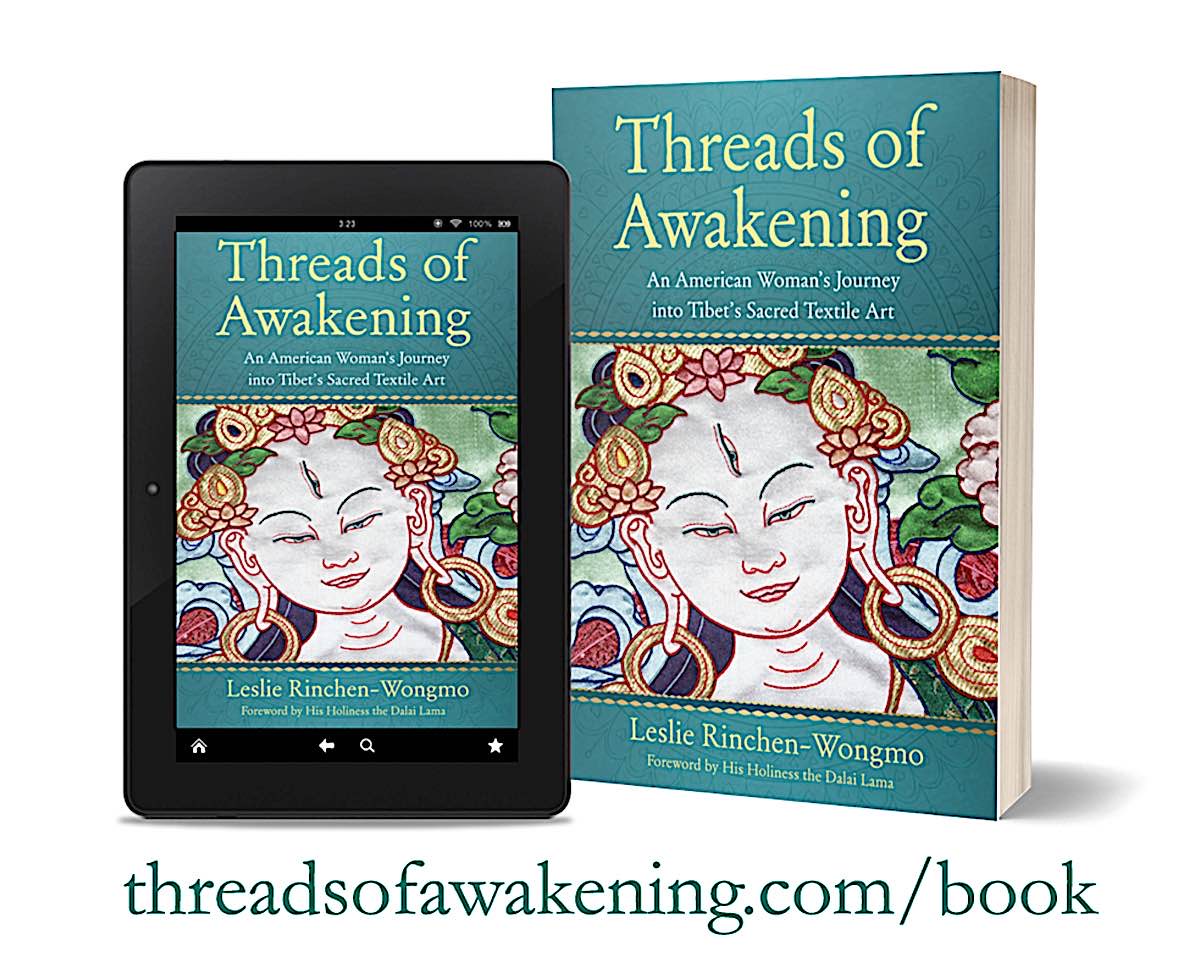
Editorial Reviews
—His Holiness the Dalai Lama“. . . the narrative threads . . . weave together in a sensitive work that considers Rinchen-Wongmo’s difficulties navigating Tibetan culture in her quest to learn a new art. . . . Along the way, it effectively delves into the Buddhist thought that she incorporated into her worldview.”
—Kirkus Reviews“Readers interested in Tibetan culture and Buddhist spiritual practices will find this book of interest.”
—Library Journal “Deeply personal, learned, and genuine, this is a beautiful memoir of spiritual self-discovery.”
—Susan Piver, New York Times best-selling author of The Four Noble Truths of Love: Buddhist Wisdom for Modern Relationships“At first glance, it seemed as if this book might be yet another travelogue, with adventures into India and a dip into Buddhist culture. How wrong I was. It is a deeply moving story of how one woman’s decision to help the Tibetan refugees in India led to a lifetime’s work of creation in one of the finest and rarest art traditions. . . . An absolute delight to read.”
—Reedsy Discovery
“Threads of Awakening is an illuminating window into the world of pieced brocade thangkas. Leslie Rinchen-Wongmo is, to my knowledge, the first American woman to master this exquisite artistic tradition, and also the first to write extensively on it. We are fortunate to reap the fruits of her endeavors!”
—Glenn H. Mullin, author of Female Buddhas and four more books on Tibetan Buddhist art
“Threads of Awakening not only fulfills a critical gap in the recorded literature and preservation of traditional Tibetan appliqué thangkas—it is also sure to enrapture, delight, and inspire you!”
—Pema Namdol Thaye, traditional Tibetan architect, artist, author, and art educator
“Part travelogue, part spiritual biography, and part artistic chronicle, Leslie Rinchen-Wongmo’s Threads of Awakening is an eloquent work that is both adventure and homecoming; transformational and grounding . . . her personable and insightful presentation stimulates introspection about our own journeys, whatever they may be.”
—Buddhistdoor Global
“All of us are granted the same twenty-four-hour day. But great memoirs show us how much life we can pack into every moment if our heart says yes. Leslie Rinchen-Wongmo, whose name means ‘precious, empowered woman,’ did just that. She came upon a group stitching sacred Tibetan tapestries in India and stayed to become the first Western woman trained to make them. Her story takes us deep into the art and culture she embraced. But just as importantly, Leslie provides a luminous lesson on what she calls ‘the experience of traveling off course to a wondrous life.’”
—Barbara Cornell, Pulitzer Prize–nominated journalist and librarian
“I was genuinely moved by Leslie’s courage and compassion as she pursued her dreams. Perhaps one of the most moving moments of the book is her meeting with His Holiness the Dalai Lama. Her book is a joy to read.”
—Cindy Rasicot, author of Finding Venerable Mother: A Daughter’s Spiritual Quest to Thailand
“Prepare yourself not just for a fascinating read but also for a profound personal awakening at the depths of your being!”
—Bill Bauman, PhD, author of Emptiness Dreaming: The Story of Creation as Seen through the Eyes of the Quantum Void
“Leslie retells her journey in prose that is as beautiful, meticulous, and captivating as the thangkas themselves.”
—Meher McArthur, author of Reading Buddhist Art
“Profoundly meaningful and deeply spiritual, Threads of Awakening is a delightful and inspiring travel memoir about an ancient Tibetan Buddhist textile tradition and a woman’s search for purpose.”
—Isadora Leidenfrost, PhD, filmmaker of Creating Buddhas: The Making and Meaning of Fabric Thangkas
About the Author
More articles by this author
Search
Latest Features
Please support the "Spread the Dharma" mission as one of our heroic Dharma Supporting Members, or with a one-time donation.
Please Help Support the “Spread the Dharma” Mission!

Be a part of the noble mission as a supporting member or a patron, or a volunteer contributor of content.
The power of Dharma to help sentient beings, in part, lies in ensuring access to Buddha’s precious Dharma — the mission of Buddha Weekly. We can’t do it without you!
A non-profit association since 2007, Buddha Weekly published many feature articles, videos, and, podcasts. Please consider supporting the mission to preserve and “Spread the Dharma." Your support as either a patron or a supporting member helps defray the high costs of producing quality Dharma content. Thank you! Learn more here, or become one of our super karma heroes on Patreon.
Lee Kane
Author | Buddha Weekly
Lee Kane is the editor of Buddha Weekly, since 2007. His main focuses as a writer are mindfulness techniques, meditation, Dharma and Sutra commentaries, Buddhist practices, international perspectives and traditions, Vajrayana, Mahayana, Zen. He also covers various events.
Lee also contributes as a writer to various other online magazines and blogs.




